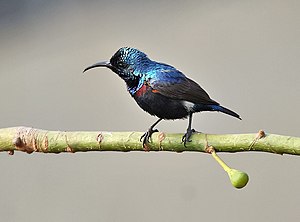 Fig: Cup nest built by Asian Paradise Flycatcher
Fig: Cup nest built by Asian Paradise FlycatcherThe cup shape nest is the 3rd inorder of simple to complex nest In my previous posts I have given information about first two type of nests.The cup shaped nest is more advanced than simple twig nest.This is the most typical form of nest and found in abundant as most flycatchers build this type of nest.The cup shape nest have a clear inside as well as an outside and the inside is lined with softer materials for more comfort.This type of nest also provide more protection for both the eggs and chicks.They are generally build at the forked branch of a tree i.e either "V" or "Y" shaped branch.These nests are build with leaves, grasses, finer twigs sticked together with cobwebs. Birds like Asian Paradise Flycatcher, Monarch Flycatcher, Faintail Flycatcher, Humming birds, Bulbul,Oriole, Drongo etc build cup shaped nest.





![Reblog this post [with Zemanta]](http://img.zemanta.com/reblog_e.png?x-id=146d830f-3a56-4676-8d6c-cb2986d4a0bf)

![Reblog this post [with Zemanta]](http://img.zemanta.com/reblog_e.png?x-id=c08f27e6-19b0-4ebf-aa35-5545d1af7cdd)

![Reblog this post [with Zemanta]](http://img.zemanta.com/reblog_e.png?x-id=8c43bb95-5f18-4ca3-93a5-eb9830af3adb)

![Reblog this post [with Zemanta]](http://img.zemanta.com/reblog_e.png?x-id=5c38c46d-8bbb-4da7-aaee-948c3188d8cf)

![Reblog this post [with Zemanta]](http://img.zemanta.com/reblog_e.png?x-id=90c705d5-beae-467b-9689-9c05cfe7cdd5)


![Reblog this post [with Zemanta]](http://img.zemanta.com/reblog_e.png?x-id=c3611a3d-9632-4ae2-a5c1-8f9f35006250)

![Reblog this post [with Zemanta]](http://img.zemanta.com/reblog_e.png?x-id=c40ecb3c-78fd-4cee-a77c-801831a5d4e3)






